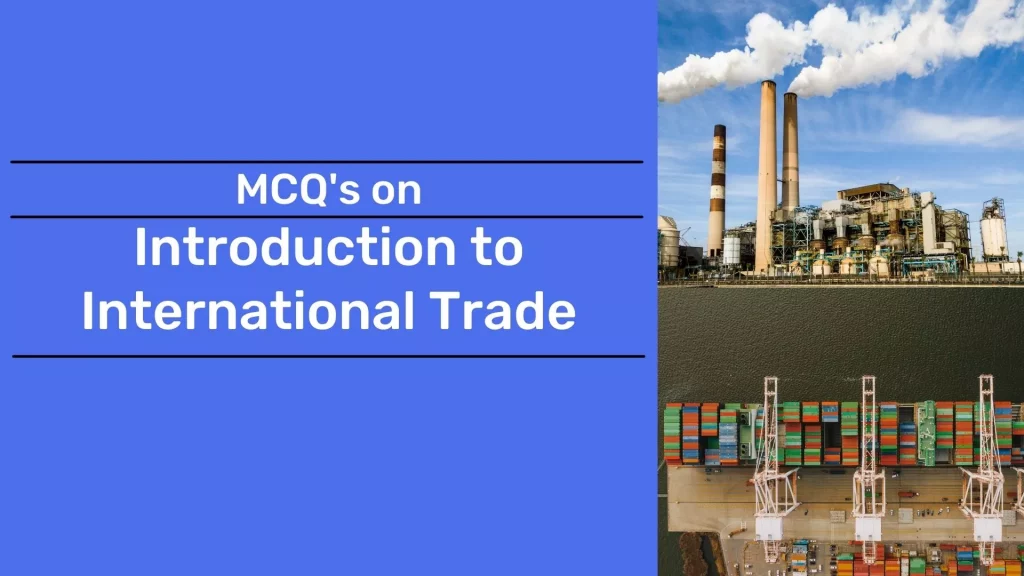40+ Introduction to International Trade MCQ | (Free Resource) Business Economics
Introduction to International Trade MCQ

1. International trade increases the welfare of _______ .
a) all participating countries
b) only exporting countries
c) only importing countries
d) none of the above
2. International trade increase the _________ of participating countries.
a) output
b) profit
c) risks
d) none of the above
3. According to David Ricardo, international trade is beneficial under _________ cost.
a) comparative
b) absolute
c) equal difference in cost
d) none of the above
4. David Ricardo’s Theory assumes perfect mobility of labour ________ .
a) within the country
b) between the participating countries
c) within and between the participating countries
d) none of the above
5. Comparative cost theory is static theory because it assumes _________ .
a) there is no qualitative and quantitative change in inputs
b) labour is homogeneous within the country
c) there is no transport cost
d) none of the above
6. Ricardian theory measures comparative cost in terms of ________ .
a) man days
b) money
c) input costs
d) all of the above
7. Ricardian theory assumes that labour is _________ within the country.
a) homogeneous
b) heterogeneous
c) inefficient
d) all of the above
8. Ricardian theory can be extended to __________ .
a) more than two countries
b) only two countries
c) only to developed nations
d) only to developing nations
9. Hecksher Ohlin theory on international trade can explain ________ trade.
a) inter-regional and international
b) only inter-regional
c) only international
d) none of the above
10. Commodity X is capital intensive, when in its production capital/labour ratio is _____ than Commodity Y.
a) greater
b) less
c) equal to
d) none of the above
| Answers: 1)all participating countries 2)output 3)comparative 4)within the country 5)there is no qualitative and quantitative change in inputs 6)man days 7)homogeneous 8)more than two countries 9)inter-regional and international 10)greater |
11. Hecksher Ohlin theory cannot be applied to more than _________ .
a) several commodities and several countries
b) two commodities
c) two countries
d) few countries
12. According to Hecksher Ohlin theory, product price depends on _________ .
a) all of the given below
b) only factor intensity
c) only factor abundance
d) factor cost
13. According to Hecksher Ohlin theory, the international trade takes place due to difference in ______ .
a) product price
b) labour efficiency
c) advanced technology
d) all of the above
14. In international trade ______ move between nations.
a) commodities and not factors
b) factors of production
c) factors and commodities
d) none of the above
15. Terms of trade are expressed as a ratio of ________ .
a) price index of exports and imports
b) foreign exchange receipts and payments
c) FDI and portfolio investments
d) none of the above
16. Terms of trade are favourable if the current index in comparison to the base year index is ________ .
a) more
b) less
c) equal
d) none of the above|
17. Gross barter terms of trade takes into account _________ .
a) trade items and unilateral payments
b) only trade items
c) only services
d) none of the above
18. Income terms of trade indicate increased capacity to __________ .
a) import
b) export
c) investment
d) none of the above
19. Single factoral terms of trade takes into account changes in __________ .
a) efficiency of factors of production of export goods
b) export prices,
c) import prices
d) demand for imports
20. Generally, the developing countries ________ terms of trade.
a) suffer from adverse
b) enjoy favourable
c) ignore
d) none of the above)
| Answers: 11)several commodities and several countries 12)all of the given below 13)product price 14)commodities and not factors 15)price index of exports and imports 16)more 17)trade items and unilateral payments 18)import 19)efficiency of factors of production of export goods 20)suffer from adverse |
21. The gain from trade is maximum if the international terms of trade are _________ .
a) nearer to the internal terms of trade of trading partner
b) nearer to the domestic terms of trade of importing country
c) equal to exporting country
d) none of the above.
22. An offer curve differs from _________ .
a) usual demand and supply curves
b) usual demand curve
c) usual supply curve
d) none of the above
23. International trade increases the welfare of _________ .
a) all participating countries
b) only exporting country
c) only importing country
d) only developed countries
24. International trade results in __________ .
a) all of the given below
b) innovations
c) reduction in costs
d) diversifies consumption
25. Cultural changes due to international trade are __________ .
a) positive and negative
b) only positive
c) only negative
d) none of the above
26. The concept of gross barter terms of trade was introduced by _______ .
a) Frank Taussig
b) Alfred Marshall
c) Francis Edgeworth
d) John S. Mill
27. The concept of income terms of trade was introduced by _________ .
a) Graeme S Dorrance
b) Frank W Taussig
c) David Ricardo
d) Francis Edgeworth
28. Utility terms of trade was introduced by _________ .
a) Jacob Viner
b) Adam Smith
c) J. S. Mill
d) Frank Taussig
29. The concept of offer curves was introduced by __________ .
a) A. Marshall and F Edgeworth
b) Adam Smith and David Ricardo
c) JohnS. Mill and John M Keynes
d) None of the above
30. Terms of trade will be favourable to a country when __________ .
a) all of the given below
b) its exports have inelastic demand
c) its imports have elastic demand
d) its supply of exports is elastic
| Answer: 21)nearer to the internal terms of trade of trading partner 22)usual demand and supply curves 23)all participating countries 24)all of the given below 25)positive and negative 26)Frank Taussig 27)Graeme S Dorrance 28)Jacob Viner 29)A. Marshall and F Edgeworth 30)all of the given below |
31. The offer curve of a country is based on _________ .
a) relative prices of two commodities
b) price of exports
c) price of imports
d) supply of exports
32. A country will have unfavourable terms of trade when ________ .
a) imports have inelastic demand
b) imports have elastic demand
c) exports have elastic supply
d) none of the above
33. When supply of exports is elastic, a country will have ________ terms of trade.
a) favourable
b) unfavourable
c) different
d) none of the above
34. The concept of reciprocal demand was introduced by ________ .
a) J. S. Mill
b) J. M. Keynes
c) G. S. Dorrance
d) F.W. Taussig
35. Reciprocal demand is expressed in terms of _________ .
a) Offer curves
b) supply curves
c) demand curves
d) cost curves
36. The classical theory of international trade was presented by __________ .
a) David Ricardo
b) Hecksher-Ohlin
c) J. M. Keynes
d) Alfred Marshall
37. Hecksher-Ohlin theory states that the relative factor prices in two countries are determined by _____ .
a) differences in factor endowments
b) labour efficiency
c) technological developments
d) none of the above
38. Hecksher-Ohlin theory is also known as ________ theory of international trade.
a) modern
b) traditional
c) classical
d) none of the above
39. Under _______ type of cost difference, international trade will not take place.
a) equal
b) absolute
c) comparative
d) none of the above
| Answer: 31)relative prices of two commodities 32)imports have inelastic demand 33)favourable 34)J. S. Mill 35)Offer curves 36)David Ricardo 37)differences in factor endowments 38)modern 39)equal |



3 Responses
[…] Introduction to International Trade […]
[…] Introduction to International Trade […]
[…] Introduction to International Trade […]